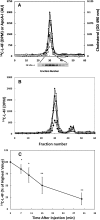Enhancement by LDL of transfer of L-4F and oxidized lipids to HDL in C57BL/6J mice and human plasma
- PMID: 21804067
- PMCID: PMC3173006
- DOI: 10.1194/jlr.M016741
Enhancement by LDL of transfer of L-4F and oxidized lipids to HDL in C57BL/6J mice and human plasma
Abstract
The apoA-I mimetic peptide L-4F [(Ac-D-W-F-K-A-F-Y-D-K-V-A-E-K-F-K-E-A-F-NH2) synthesized from all L-amino acids] has shown potential for the treatment of a variety of diseases. Here, we demonstrate that LDL promotes association between L-4F and HDL. A 2- to 3-fold greater association of L-4F with human HDL was observed in the presence of human LDL as compared with HDL by itself. This association further increased when LDL was supplemented with the oxidized lipid 15S-hydroxy-5Z, 8Z, 11Z, 13E-eicosatetraenoic acid (15HETE). Additionally, L-4F significantly (P = 0.02) promoted the transfer of 15HETE from LDL to HDL. The transfer of L-4F from LDL to HDL was demonstrated both in vitro and in C57BL/6J mice. L-4F, injected into C57BL/6J mice, associated rapidly with HDL and was then cleared quickly from the circulation. Similarly, L-4F loaded onto human HDL and injected into C57BL/6J mice was cleared quickly with T(1/2) = 23.6 min. This was accompanied by a decline in human apoA-I with little or no effect on the mouse apoA-I. Based on these results, we propose that i) LDL promotes the association of L-4F with HDL and ii) in the presence of L-4F, oxidized lipids in LDL are rapidly transferred to HDL allowing these oxidized lipids to be acted upon by HDL-associated enzymes and/or cleared from the circulation.
Figures









Similar articles
-
An apoA-I mimetic peptide containing a proline residue has greater in vivo HDL binding and anti-inflammatory ability than the 4F peptide.J Lipid Res. 2009 Sep;50(9):1889-900. doi: 10.1194/jlr.M900151-JLR200. Epub 2009 May 11. J Lipid Res. 2009. PMID: 19433476 Free PMC article.
-
High-density lipoprotein and 4F peptide reduce systemic inflammation by modulating intestinal oxidized lipid metabolism: novel hypotheses and review of literature.Arterioscler Thromb Vasc Biol. 2012 Nov;32(11):2553-60. doi: 10.1161/ATVBAHA.112.300282. Arterioscler Thromb Vasc Biol. 2012. PMID: 23077141 Free PMC article. Review.
-
Apolipoprotein A-I mimetic peptide helix number and helix linker influence potentially anti-atherogenic properties.J Lipid Res. 2008 Jun;49(6):1268-83. doi: 10.1194/jlr.M700552-JLR200. Epub 2008 Mar 5. J Lipid Res. 2008. PMID: 18323574 Free PMC article.
-
The effect of HDL mimetic peptide 4F on PON1.Adv Exp Med Biol. 2010;660:167-72. doi: 10.1007/978-1-60761-350-3_15. Adv Exp Med Biol. 2010. PMID: 20221879 Review.
-
Effects of D-4F on vasodilation and vessel wall thickness in hypercholesterolemic LDL receptor-null and LDL receptor/apolipoprotein A-I double-knockout mice on Western diet.Circ Res. 2005 Nov 25;97(11):1190-7. doi: 10.1161/01.RES.0000190634.60042.cb. Epub 2005 Oct 13. Circ Res. 2005. PMID: 16224061 Free PMC article.
Cited by
-
L-4F inhibits lipopolysaccharide-mediated activation of primary human neutrophils.Inflammation. 2014 Oct;37(5):1401-12. doi: 10.1007/s10753-014-9864-7. Inflammation. 2014. PMID: 24647607 Free PMC article.
-
D-4F-mediated reduction in metabolites of arachidonic and linoleic acids in the small intestine is associated with decreased inflammation in low-density lipoprotein receptor-null mice.J Lipid Res. 2012 Mar;53(3):437-445. doi: 10.1194/jlr.M023523. Epub 2011 Dec 13. J Lipid Res. 2012. PMID: 22167743 Free PMC article.
-
An apoA-I mimetic peptibody generates HDL-like particles and increases alpha-1 HDL subfraction in mice.J Lipid Res. 2012 Apr;53(4):643-52. doi: 10.1194/jlr.M020438. Epub 2012 Jan 27. J Lipid Res. 2012. PMID: 22287724 Free PMC article.
-
High-density lipoprotein mimetics: promises and challenges.Biochem J. 2015 Dec 15;472(3):249-59. doi: 10.1042/BJ20150832. Biochem J. 2015. PMID: 26613945 Free PMC article. Review.
-
A mechanistic paradigm for broad-spectrum antivirals that target virus-cell fusion.PLoS Pathog. 2013;9(4):e1003297. doi: 10.1371/journal.ppat.1003297. Epub 2013 Apr 18. PLoS Pathog. 2013. PMID: 23637597 Free PMC article.
References
-
- Anantharamaiah G. M., Jones J. L., Brouillette C. G., Schmidt C. F., Chung B. H., Hughes T. A, Bhown A. S., Segrest J. P. 1985. Studies of synthetic peptide analogs of the amphipathic helix. Structure of complexes with dimyristoyl phosphatidylcholine. J. Biol. Chem. 260: 10248–10255. - PubMed
-
- Anantharamaiah G. M. 1986. Synthetic peptide analogs of apolipoproteins. Methods Enzymol. 128: 627–647. - PubMed
-
- Segrest J. P., Jackson R. L., Morrisett J. D., Gotto A. M., Jr 1974. A molecular theory of lipid-protein interactions in the plasma lipoproteins. FEBS Lett. 38: 247–258. - PubMed
-
- Segrest J. P., Jones M. K., De Loof H., Brouillette C. G., Venkatachalapathi Y. V., Anantharamaiah G. M. 1992. The amphipathic helix in the exchangeable apolipoproteins: a review of secondary structure and function. J. Lipid Res. 33: 141–166. - PubMed
-
- Anantharamaiah G. M., Mishra V. K., Garber D. W., Datta G., Handattu S. P., Palgunachari M. N., Chaddha M., Navab M., Reddy S. T., Segrest J. P., et al. 2007. Structural requirements for antioxidative and anti-inflammatory properties of apolipoprotein A-I mimetic peptides. J. Lipid Res. 48: 1915–1923. - PubMed
Publication types
MeSH terms
Substances
Grants and funding
LinkOut - more resources
Full Text Sources

